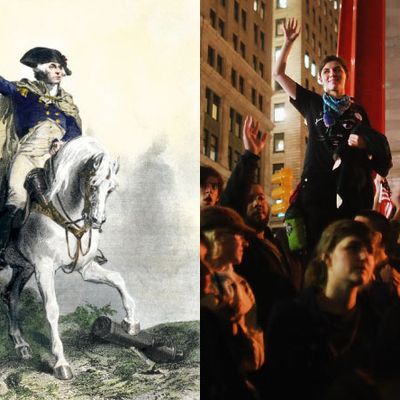
This morning, when we here at Daily Intel learned that the Occupy Wall Street protesters had been forced out of the strategically crucial Zuccotti Park, at least temporarily, and had been forced to seek out less desirable encampments further north to ensure their survival, it reminded us of another event in the city’s history: George Washington’s 1776 New York campaign. Swarmed by a force of British soldiers and sailors, who outnumbered the city’s residents, General Washington was forced by a series of losses in the surrounding area (Long Island, Staten Island, and Brooklyn) onto the island of Manhattan, where his men set up encampments downtown, mostly below Canal Street. But the British followed, and set up their own garrison there. The overwhelmed Washington faced a crucial decision: Should he stay and fight? Should he flee, and if so, where? Perhaps, we thought, there is a lesson the Occupiers can glean from his decision, and so we asked a few eminent military and Revolutionary War historians how the demonstrators should proceed.
Our favorite answer came from Edwin Burrows, the distinguished co-author of Gotham: A History of New York City to 1898, who replied “LOL. They’re toast!” But he expanded a bit: Like Washington before them, perhaps the Occupiers could flee still further northward, to Harlem Heights and Washington Heights, on what was then farmland. From there, after losing yet another battle, Washington’s army crossed the river into New Jersey, where they fought the tide-turning Battle of Trenton. Lose the battle, win the war?
But, as Benjamin Carp of Tufts pointed out, a move uptown or cross-river would mean the Occupiers would probably lose the media exposure they’re getting here — perhaps as important for them as the physical turf was for Washington. “One of the big issues for Washington would have been to keep his army together, and to make sure that he himself was not captured.” For the leaderless OWS, “a strategy of dispersal might work well for them,” perhaps in several of the city’s other privately owned public spaces. (Or, if they’re looking for more attention, why not call in Adrien Chen’s chips on his tongue-in-cheek tweet offering the Gawker roof deck?)
Dispersal would also help keep the neighbors placated — something Washington had to deal with, as well. “You have to remember he was fighting a civil war,” said Carp, and not everyone was sympathetic to his aims. “Washington was very crafty about trying to make sure the presence of the British was more obnoxious than the presence of the American soldiers.” Occupy Wall Street probably took a big step forward in that propaganda war this morning, with the harsh-seeming tactics of Mayor Bloomberg and the NYPD on very public display.
Washington had a third option, other than flee or fight, when he was booted from downtown: He could have burned the city. In fact, there was a large, suspicious fire in the area, not far from the modern-day World Trade Center and Zuccotti Park. There’s some evidence that it was started by American soldiers, either under orders from the general or by rogues. A full-scale, Washington-ordered torching would have been a PR disaster, of course, in winning over the citizenry — and similarly, although OWSers could go the scorched-earth route, inciting more violence and getting angrier and angrier, they’d probably be better served in the end by not destroying their environs, even if they are on the way out of the ’hood.
Either way, like Washington, they’re facing an even more stalwart foe than the Brits or the Bloomberg administration: winter. Washington’s famously faced a winter of deprivation camped at Valley Forge, but he also had winter camps in the New York area, in Morristown, New Jersey, for instance. Winters were more about survival than military campaigning, but neither Washington or OWS could very easily send the troops home (or exclusively onto the Internet) for the cold months and maintain any semblance of a strong showing. Things got rough out there, though. “Continental troops were reduced to eating their shoe leather,” said Carp. “I don’t think the Occupy movement wants to end up there.”





























